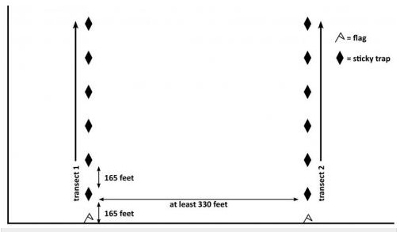By Erin Hodgson, Ashley Dean
Western and northern corn rootworm are major corn pests in Iowa and surrounding states (Photos 1 and 2). Farmers have seen several management changes, including the release of four Bt-rootworm traits to suppress corn rootworm larvae since 2003. Although both species are persistent pests, western corn rootworm is particularly adaptable. The Gassmann Lab at Iowa State University (ISU) has confirmed western corn rootworm resistance to all Bt rootworm traits in Iowa.
Photo 1. Color and size variation of western corn rootworm.
Photo 2. Color and size variation of northern corn rootworm.
In order to prolong the effectiveness of Bt, farmers should monitor for corn rootworm and make management decisions based on larval injury to roots or adult activity. We recommend using the
0 to 3 node-injury scale developed at ISU to evaluate larval injury.
Corn rootworm egg hatch peaked mid-June this year, and adults are beginning to emerge in many fields.
Adult emergence coincided with silking in corn this year throughout much of Iowa. This can be problematic as adults can clip silks and interfere with pollination. To monitor for adults, follow the guidelines outlined below. Use Pherocon AM yellow sticky traps (unbaited). Set up sticky traps at corn silking and continue through the dent stage (i.e., mid-July through August). For areas in eastern counties with suspected rotation-resistant western corn rootworm, set up sticky traps at soybean flowering and continue through full seed set (i.e., mid-July through August).
Guidelines for sampling adult corn rootworm
- For every 10-50 acres of corn or soybean, create two transects of six sticky traps/transect (Figure 1). Transects should be at least 330 feet apart. Use a flag or stake to mark transects along the field edge.
- Place the first trap at least 165 feet in from the field edge; place remaining traps within the same row and at least 165 feet apart.
- For corn, attach the sticky trap directly to the developing ear. For soybean, attach the sticky trap to a post approximately 18 inches above the canopy.
- Check traps weekly and count the number of western and northern corn rootworms. Replace sticky traps weekly and adjust trap height if needed.
- For each sample, estimate the average number of western and northern corn rootworms per trap per day. For example, 123 total corn rootworms/12 traps/7 days = 1.46 rootworms/trap/day.
- Action thresholds in corn are two corn rootworms/trap/day, regardless of species. Consider crop rotation if action thresholds are met. If planting corn again the following growing season, use a pyramided Bt trait with Cry34/35Ab1, or a soil-applied insecticide on non-rootworm Bt corn. Action thresholds in soybean are 1.5 western corn rootworms/trap/day. If action thresholds are met in soybean, consider using a pyramided Bt trait or a soil-applied insecticide on non-rootworm Bt corn the following season.

Figure 1. Schematic drawing of adult corn rootworm sticky traps in corn or soybean fields.